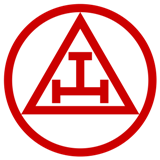From Masonic Footprints, Vol 4, No 6, July Sept 2015 This Order dates in England, as a separate ceremony, from about 1740, according to Oliver Kloss who states that it was introduced, from the continent, during the Austrian War of succession in 1742. Its creation is attributed to the ‘Antients’, for as late as 1758 the ‘Moderns’ had no Royal Arch. Under the ‘Modern’ regime the true M.M.’s word was revealed in the Lecture of the Third Degree, which practice continued until about 1766, when Dunckerley was commissioned by the Modern’s Grand Lodge to revise the Lectures. He transferred the True Word from the Third degree to the Royal Arch, thus to some extent blending the ‘Antient’ and ‘Modern’ systems. There is evidence that a Chapter worked in Stirling in 1743, and also one in Bristol in 1757, also we know that Laurence Dermott of the ‘Antients’ Grand Lodge worked it as a separate ceremony. In the very early days of Freemasonry prior to 1720, only the Degrees of Entered Apprentice and Fellow Craft were worked, and it was not until 1727 that the Master Mason Degree appears. From this date separate Lodges were formed for conferring this Degree. By the transference of the true M.M.s Word to the Royal Arch by Dunckerley the latter became the completion of the M.M. Degree, as we consider it today, and it is for this reason that every M.M. should make every endeavour to be exalted to this Supreme Order, for without it his Masonic education is necessarily incomplete. Supreme Grand Chapter of England was formed in 1769, and from that date to the Union in 1813, 173 warrants were issued. In the Act of Union dated 27th December, 1813, this Supreme Order was defined as an integral part of Craft Masonry, thus:-“The English Rite of Freemasonry is authoritatively declared to consist of the Entered Apprentice, the Fellow Craft and the Master mason including the Supreme Order of Holy Royal Arch.” In former times this ceremony was restricted to those Brethren who had passed the Chair in the Craft. In 1813 however, twelve months service as Master Mason was necessary qualification. This again was altered in 1893, four weeks as a Master Mason being all that was required. |
Devotion Newsletter Content > Education & Editorial Articles > Masonic History and Things Historic >

